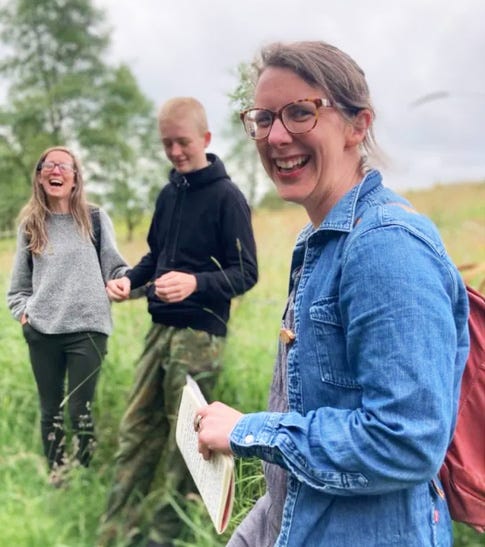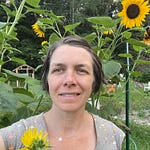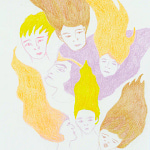Like many people, I learned about permaculture as an approach to help me understand how to grow food in a more sustainable way. But Liz’s approach goes way beyond the garden.
Liz Postlethwaite is a community artist and permaculture designer who has blended her love of both to create a unique course teaching permaculture principles to artists and creatives. As Liz explains, permaculture is all about creating regenerative systems, and the tools and framework provided by permaculture are applicable to different areas of modern life.
Join me for a wonderful conversation with Liz learning about permaculture, it’s provocation and principles, and why this might be the perfect moment for permaculture to be more widely used as a tool for regeneration at a time when we desperately need positive action and change.
Liz mentions a few other permaculture designers that I wanted to link here as well:
Tyson Yunkaporta is an indigenous skolar (Apalech clan (Wik) Lostmob Nungar) working with Indigenous Systems Knowledge and collective Indigenous inquiry methods inflected with complexity science to resolve global existential threats and issues in regenerative design responses to crises.
Looby Macnamara is a permaculture teacher, designer and writer who lives in Herefordshire with her partner and two daughters. Together they host Applewood Permaculture Centre, an education and demonstration centre.
Dan Palmer hosted a permaculture podcast called Making Permaculture Stronger about regenerating permaculture design process together. The podcast saught to uncover core ideas about what permaculture design process is and bring them into open with a spirit of collaborative inquiry to reveal and walk down deeper and more powerful pathways toward life.
You can support this project and podcast by becoming a paid subscriber here on Substack.
If you have a person or project who you think is doing really awesome work in their community, please recommend them by emailing me at kel@novitasmag.com.
TRANSCRIPT (please excuse the typos)
Intro: Welcome to Novitas, a podcast exploring stories about living outside the capitalist paradigm towards collective liberation. My name is Kel Smith and my guest today is Liz Postlethwaite, an artist and permaculture designer living in the UK. While most people associate permaculture as a land-based practice, Liz has a unique approach of teaching her love of permaculture design through a course designed specifically for artists and arts organizations.
She talks about the provocation of permaculture design, using systems thinking, taking inspiration from the natural world, and of course the permaculture ethics. I love this application of the permaculture principles outside of agriculture, and Liz's deep knowledge around the topics of sustainability, resilience, extraction, and regeneration come through in this wonderful conversation. I hope you'll enjoy.
Kel: Hi Liz, do you want to take a minute and introduce yourself and maybe talk a little bit about how you came to permaculture practice?
Liz: Well I always find it hard to introduce myself because I'm not quite sure what I do really but my name's Liz Postlethwaite and I'm based in Manchester, just north of Manchester which is in the north of England, in the United Kingdom. And I came to permaculture design, think about four years ago. I did a PDC about 12 years ago, a permaculture design course. I came to it on my gardening perspective. And as we'll probably talk about today, my practice as a permaculture designer is really around art and creativity. I'm an artist by trade, I'm a performance maker, a theatre maker. So it's been about bringing together permaculture design, which is originally a land-based design practice and a participatory art practice and trying to let them understand what those two things look like when they come together.
Kel: Right, so I know permaculture as a practice can be a bit confusing for people because as you say, it starts very much as a land-based practice or gardening or growing food, kind of focused around that for most people, but then also covers a lot of different topics in areas. Can you give a brief primer on what permaculture is for you?
Liz: Yeah, I mean, I think it's interesting because a lot of people do come to permaculture design thinking it's like just a land-based practice. And actually, historically, it was never intended just to be a land-based practice. And that's how permaculture design started to emerge. But actually, when Bill Mollison was exploring the ideas around permaculture design, he was acutely aware of the fact that he, in an industrialized culture that he was part of, had become disconnected from a connected way of being with the land. So actually what he was really interested in was, how can we live... Hhe used the word sustainably, but I know sustainable is a bit of a funny word now... How can we live our lives with the least impact on the planet and in a way that's connected to the planet? So I think that thing of people seeing permaculture design as a land-based practice, it is, but that's just one tiny part of what it is. It was always envisaged or envisioned as a way of designing all interactions that humans have.
But I think what's interesting is for a lot of people, they come to it from food growing, because as soon as you start to grow a little bit of food, you realize that everything's interconnected.
Kel: It's so true.
Liz: So for a lot of people, like for me, food is, trying to grow food or growing food is a gateway to understanding the interconnectedness of things.
Kel: Right.
Liz: Yeah, does that answer your question?
Kel: Yeah, for sure. So we know that permaculture is definitely more about growing food. Do you want to talk about some of the other parts that permaculture contains or touches?
Liz: Yeah, so I think it's quite interesting. So I think one thing that's quite interesting to define is that people talk about like permaculture, like permaculture is this fixed thing that's set in stone and I find it a bit weird when people talk about permaculture as a noun. Because to me, permaculture is a verb, permaculture is something that you do, and it's a set of tools that help you make regenerative things. So in that sense, the provocation of permaculture design is about making regenerative things. And if we take regenerative to mean things that are connected or reconnected with the living systems and the kind of pulse of life that exists on this planet.
If we're thinking about regenerative in the sense of practices that reconnect us with those life-giving processes, then that's the provocation. And I think it's really important to frame as well that it's only our industrial cultures that have lost connection to those life-giving processes. For millennia, that's how humans have lived on the planet and there's still many cultures and cultural practices that have got continuous tradition and continuous practice of being connected to living cycles on the planet. And I think it's interesting because then people often say well permaculture design is about appropriating kind of cultural traditions or knowledge that doesn't, that isn't ours to appropriate and to me if permaculture design is doing that then that's not permaculture design because that's not an embodiment of the permaculture ethics. To me, work share, Earthcare, People Care, Fair Share, to me permaculture design is about me from an industrialised culture recreating ways of being that are connected in a way that isn't about appropriating or taking other people's practices or other people's stories or things that aren't mine to take.
Kel: Right, I think it's so important to be able to identify what is, you know, traditional ecological knowledge, what is appropriation, and then what is also like us learning how to live in a way that is more harmonious with the earth and that doesn't have to be appropriation, right?
Liz: It's quite interesting, I mean I find it quite, I'm not really in a position to talk about this because of kind of my background, you know, it's not my knowledge or my place necessarily to talk about ownership of indigenous wisdom or different cultural practices but I think there's got to be a place... I really like hearing Tyson Yunkaporta talk about it and Tyson Yunkaporta is a permaculture practitioner and is really interested and really kind of deeply knowledgeable from a personal perspective and a personal heritage of the interaction between permaculture practices and traditional ecological knowledge and where those two things meet and where those two things potentially clash with each other. But we've got to find a way and we've got to find a way to be together and we've got to find a way to respectfully nod to other people's knowledge in a way or ask or have conversations with people. And I suppose that's about community-ship and about relationships and kind of how we share knowledge but don't own knowledge.
Kel: Right, yeah.
Liz: And I think there's sometimes this tendency that of like wanting to own certain knowledge without honoring the cultural practices that historically run alongside that knowledge. And that's really, really challenging. Yeah, it's just so complicated and a lot of the times like when you work, a lot of the creative people, because a lot of my work now is I've developed a permaculture design course for artists and creatives and for a lot of people when they start on that journey the question is, becomes a kind of design process of what does it mean wherever you are as an individual to be indigenous again, to be indigenous to place and I'm like a British person living in the north of England with Irish heritage. So how can I even start to think about what that might mean?
Kel: Right, for sure.
Liz: You know, so it's really, really complicated.
Kel: Yeah. Can I ask a little bit about the course that you've developed?
Liz: Yeah, sure.
Kel: That's really interesting. So we talked a little bit about the fact that like permaculture is more than just food and more than just growing food and even more than one's connection to the land because it's also about connection to people and space and heritage and ancestry and living life in a more regenerative way. How does that work for artists? Do you focus on the food side of things? Because I know most PDCs are very specific around food, right? So how does that play out?
Liz: I find it really interesting because when a garden is regenerative, we know what it looks like. It's kind of easy to know what it feels like because it's thriving in a certain way. I always use the example of woodlands. If you go into a woodland or a forest, a natural woodland or forest that's thriving, you just can feel what the regenerative process feels like in that place and it's hard to put a finger on what it means but if you go to a garden that kind of got those processes in place but we know that it's not just our gardens that need to be regenerative. Our hospitals need to be regenerative, our schools, our transport systems, our absolutely everything and that's like more complicated. It's easy to say what a regenerative garden looks like or easier but what does a regenerative school look like? What does a regenerative cultural and arts practice look like? And I'm not a farmer. I grow food. I've always grown food most of my adult life. But for me, after I did my permaculture design course, what I became really passionate and interested about was how can I take this learning to have most impact within my niche?
Kel: Yeah.
Liz: And my niche is like the arts and the cultural sector, so what might that mean? And what I was really interested as well is that my arts practice has always been like a participatory arts practice, working with people, working with communities. And a big part of permaculture design is about kind of embracing the abundance of edges, like we know in ecosystems that often the most abundant and the most dynamic ecological relationships happen at the edges of ecosystems or where one ecosystem meets another. And a lot of participatory arts practice is operating in the same spaces socially. So for me, there was like a natural crossover between the permaculture design practice and participatory arts practice. And then I was really interested that I felt that the tools of permaculture design can bring a lot to arts practice, but I also permaculture design is a process of imaginative observation. So I think there was this really good crossover. So then I got really interested in, well, if there was a permaculture design course for artists to help us design arts practice or arts organisations, what would that look like? Because I'm often really aware that artists making work or arts organisations make work about the climate or about the environment in ways which is damaging to the environment. So they make a show about the climate and everyone's come there on a plane and they bank with a bank that's invested in oil and they use plastic and so I'm interested in like that contradiction as well that actually it's really important to say those things and have those conversations, but like actually what's important as well is the structures that support those conversations.
So the Permaculture Design course that I run, there is a curriculum for the Permaculture Design course, there's certain things that you have to cover, but all of those things are then about reflecting back about that deep knowledge of the natural systems that you get from a permaculture design course and thinking about how that might inform your arts practice or the organisation that you're creating or the way that you're working or the stories that you're telling and what like what would generative practices mean because I always find it really interesting.
We were talking about forest gardens and I always find it really weird when people say, oh a forest garden is a permaculture garden. Well it might be but it might not be because if everybody is exploited to make the garden, well there's no people care there. And if the materials are kind of extracted from all over the world, there's no earth care. If the garden is not accessible, there's no fair share. So it's kind of like a big part of permaculture design course is about learning ways to enact the permaculture ethics. And in that sense, what I think is really interesting about the permaculture ethics is they're really closely aligned to the kind of ethical or cultural ideas that sit at the heart of most indigenous cultures. And that's partly to do with the research and the way that Bill Mollison himself acknowledged how deeply indebted he was to those cultural classes and cultural knowledge, but there's something in those ethics which is about the essence of humanness in the context of a living culture.
Kel: Right. That's really cool. I'm interested in this idea of taking the permaculture design principles and then applying them to different sectors beyond agriculture and growing food because it really does balance this idea of, you know, theory and praxis where sometimes I know a lot of people that come to permaculture design are looking specifically for like how do I grow better food or how do I do whatever I'm doing in a better way and that's very, you know, tangible. And then there's also a lot of discussion around the theory behind how do we live in better harmony with the planet and with each other and all that kind of stuff. So it's this cool kind of balance where you can take these ideas and then find practical ways to implement them based on whatever you're working on, wherever you are, whoever you're working with. So that's really cool. Have you heard of anybody else taking that idea of taking these principles and applying them to different sectors or different areas?
Liz: Yeah obviously there's kind of really established permaculture practitioners like Luby McNamara who are looking at like people in permaculture and she was like one of the pioneers of kind of taking permaculture tools and looking at them within kind of social contexts. And I think there's kind of a growing interest in actually there's more possibility to this and we might originally envisage there to be.
Break: You're listening to Novitas, a podcast that explores stories and systems about living outside of capitalism. I'm speaking with Liz Postlethwaite, a permaculture teacher and designer, about exploring the foundations of the permaculture system and how it can be applied to how we design and live our lives. Liz was a contributor to the first issue of the Novitas magazine, which is now currently sold out. However, the next issue is in the planning stages so keep your eyes open for more news on that issue coming soon. You can follow along on our website at www.novitasmag.com. Now back to the conversation with Liz.
Liz: I think it's quite interesting though, because when you're thinking about permaculture design, you're thinking about systems, ecosystems, and you're thinking about wholes. And I think before I did permaculture design, my life was like, it was like compartmentalized.
Kel: Yeah.
Liz: It was like, this is where I'm an artist, and this is where I'm this, and this is where I'm that. But the more that you understand about the living world, the more that you understand that wholes are messy and entangled, complicated and intertwined. So to me, I couldn't have a permaculture garden if I wasn't trying for all other parts of my life. And of course, if we are working in organizations where everyone's burnt out and no one's paid properly and like we're extracting creativity and ideas from people, then they're extractive practices. And so I think the challenge of the regenerative for us in the positions of great privilege that we live in, a privilege which is supported by other people's suffering, it provokes us to ask really challenging questions and show up to answer them honestly and in ways that are not defensive.
Kel: Right. That's an easy one to fall back on. It actually flows really nicely into the next question I have listed here. You talk in the magazine specifically about permaculture ethics. And for me, that aligns really well with this idea of post-capitalism. Because I think, as you mentioned, the ways that capitalism extracts in every sector is very much in opposition to what permaculture ethics might look like?
Liz: This is not, this is my opinion. To me, permaculture design is anti-capitalist. You know, they're opposites of each other. And so that's why I find it really curious when people say, oh, you know, I've set up a, I've moved from Manchester to Costa Rica and I've set up a permaculture farm and and what the process is are all in contradiction to the permaculture ethics.
Kel: Right.
Liz: So I think that's why to me the ethics are really a really kind of powerful grounding compass as to... I don't want to say if something's really permaculture or not permaculture.
Kel: Right, but maybe the varying degrees of which we might consider it a permaculture practice.
Liz: Maybe it's better to say whether something is regenerative or not. Like there's loads of... I don't know if it's the same in Canada, but there's loads of ads on the TV now in the UK for like, there's a company that makes oven chips in the UK, right?
Kel: Okay.
Liz: The oven chips come in a plastic bag and they're in the freezer at the supermarket. And, but the advert is "we use regenerative agriculture". Now they might be using regenerative agriculture, but it's not a regenerative whole. So I think that the permaculture ethics almost invite us to look at the whole and to understand the whole and to try and understand balance. And if you look at the permaculture ethics, to me, the massive problem trouble that we are in is an absence of those ethics.
Kel: Right. Do you want to talk a little bit about what those ethics are? That's the people care, earth care and fair share, right?
Liz: Yeah.
Kel: So what do those mean?
Liz: So just to go back to very quickly, so permaculture design, the provocation at the heart of permaculture design is to create regenerative things using three different elements. The first element is to take inspiration from the natural world. And by association, that also means take inspiration from traditional ecological knowledge. The second provocation, the second part within it is about systems thinking and thinking of systems design and thinking from the perspective of the whole. And the third part is about having an ethical basis.
And the permaculture ethics are central to the permaculture design process. And so and what's quite interesting about that is that it's easy to take inspiration from nature. Or to try to. It's easy to try to live ethically, it's easy to try to do systems thinking and systems design, but it's hard to do all of those three things together. And there's no other there's nothing else that makes that suggestion that maybe we need to do those three things together. So the ethics are really central and the ethics is this idea of Earthcare, people care and fair share, which is the third ethic or future care is often used for that third ethic as well. So it's how those ethics are kind of centered within the design process, I suppose, and how they ground things.
And a really good example that I often use is the difference between biomimicry and permaculture design. And people say, well, what's the difference between biomimicry and permaculture design? Because biomimicry is often systems thinking and biomimicry is taking inspiration from nature. But if you're using biomimicry, they presumably often that shoe is still made in an exploitive working condition probably by children and it's made out of unsustainable materials whereas the aspiration would be that the permaculture ethical basis would prevent that from happening.
Kel: We've talked a little bit, I don't know, would you consider permaculture design part of an environmental movement or does it kind of transcend beyond that?
Liz: I don't know, I mean I suppose what I like about permaculture design is that it's a really broad range of people using it. I would say that my permaculture design practice has been closely aligned to environmental activism but I don't think that's true of everybody who is using permaculture design necessarily. So I think that's quite a personal thing probably in terms of how people are using those tools. I would say it is an environmental practice.
Kel: Fair. You mentioned a little bit earlier about using the word sustainable. And I think in environmental movements and permaculture as well, there's kind of this flurry of words that people use like sustainable or regenerative or resilience. And what do you think about the difference between those words and how when you're using permaculture design to look at different systems, where does it move from sustainable to regenerative?
Liz: So I think what's really interesting about sustainability is that sustainability is interrelational, all right? So the way I like to see it, if you had a line, extractive is a line going down because you're always taking things and so the resources that are available just dwindle and become less and less and less and less. And that's what's happening or has happened with our extractive practices on this planet. To me, sustainable is kind of a flat line. So sustainable is about the continuation of something. So there's two different challenges with that. Number one is that if the planet is already really extracted, what are we sustaining? And the other problem is that if you're talking from like ecosystems perspective or ecological perspective, and nothing is consistent, there's always shocks within a system. So if you've got a sustainable system that's flat and then it suffers a shock, it drops down a bit and then it drops down a bit next time. So it's the regenerative processes in nature that allow a sustainable system to be resilient because the life-giving processes mean that the system can recover from shock.
And that's like, I find it really weird about the way we use the word resilience because we say, oh... because resilience is about interconnectedness and it's about being in relation with things. And we say, oh, kids need to be resilient. They need to be able to recover from shocks. They need to be able to deal with bullying because they won't be resilient otherwise. But when you look at resilience in terms of true ecological systems and ecological processes, things are only able to be resilient because of relationships with other things.
Kel: Because they're supported.
Liz: Yeah, but within capitalism, resilience is a personal responsibility. And it's something that we say that people should be able to do on their own. So to me, that's the big difference. And actually, the reason that sustainable is a challenging word for me is what we need to be thinking about is about regeneration, but also kind of restorative processes and healing processes and not just restore healing processes for natural world but by association for ourselves as part of that kind of complex living planet.
So to me when people embark upon like a permaculture design, the permaculture design course, that little thing that we've just been talking about, about these like graphs of like down, that's extractive, this is sustainable, this is regenerative, this is what resilience means, that is like such a light bulb moment for so many people because it makes people go, oh my God, like so much of what I've been aspiring for or what I've been doing is just so far away from where I want to be or where I need to be. A really good way of describing it is a way that my friend or colleague is a regenerative farmer in North Wales. And he often says, think about a person and think about a person who you really value their relationships that might be partner or your child or a friend and just think about like how you feel about that relationship and how important that is to you. And then think about how would you feel if they describe that relationship as sustainable, right? And how would you feel if they described it as regenerative? And there's something about that. The proposition is very different and there's something dynamic and beyond our control about the regenerative.
And I think what's really interesting as well is that you can't make regenerative. You can only hope to create the context in which it can make itself, because there are infinite things in the incredible wild world that are far beyond our understanding or our control. I think part of this, these little steps that permaculture design has helped me make or helped me take, and I hope it helps other people take as well, is about, um, how we create structures for ourselves that allow us to embrace the wildness of the world. And by association, the unexpectedness of regenerative processes and that's really hard when the capitalist culture wants us to believe and modernism wants us to believe that the world is a fixed point and that progress only happens in one direction.
Kel: And that we could control it.
Liz: And that we could control anything! I suppose for me one of the things about permaculture design as well... so I did my PDC and then I did a diploma in permaculture design and I just feel like if now is not permaculture's time, when is it gonna be? Do you know what I'm like? And I think what's really powerful about permaculture design is you don't have to go to like, obviously I teach permaculture courses, so this feels like a little bit of a, but I've got like a book on my desk here, like right next to me about permaculture design. You can read that book and you're a permaculture designer. Permaculture belongs to, it doesn't belong to anybody, it's a community of practice. In that sense, it belongs to everybody and it's something that we can all contribute to and participate in and it's not perfect and some of the hierarchies that exist and in the, I was going to say the real world, the rest of the world are being replicated in permaculture design and we have to keep calling those things out and keep challenging those things out. And some of the kind of cults of exceptionalism and personality are being repeated. And again, like we have to keep calling them out. But the reason I continue with it is because I haven't found anything better.
Kel: Right. Well, and I think, again, it's not the fault of permaculture or the design process or any of the ethics or the provocation. It's more about the implementation.
Right. So ensuring that if you're interested in learning more, find good resources and make sure that those resources are people who are embodying those those ethics as well.
Liz: Yeah. And also about aside from all those critiques, which are really important and I'm like more happy than anybody to jump into those conversations and like amazing people like Dan Palmer. Dan Palmer did so much through his Making Permaculture Stronger podcast, having these conversations about criticism and kind of opening that conversation. But equally, regardless of the imperfections, I would rather see a hundred people using permaculture imperfectly and a hundred people doing nothing because they're worried about it not being perfect.
Outro: Thanks for listening to the Novitas podcast. I'm Kel Smith, and I want to thank my guest today, Liz Postlethwaite, for sharing her deep knowledge and passion for permaculture and exploring the possibilities of what we might accomplish extending permaculture principles into a post-capitalist society.
If you'd like to learn more about Liz, you can visit her website at lizpostlethwaite.co.uk. That's L-I-Z P-O-S-T-L-E t h w a i t e dot co dot uk. If you're feeling moved to support this podcast, you can become a paid subscriber on the substack at novitas dot substack dot com. You can also check out our website at novitasmag dot com or follow on instagram at novitasmag. Thanks again for listening.
















Share this post